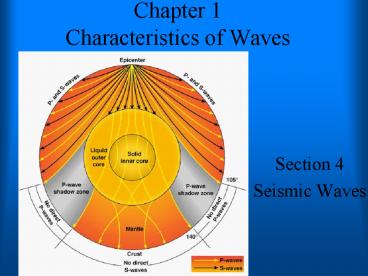Chapter 1 Characteristics of Waves - PowerPoint PPT Presentation
1 / 11
Title:
Chapter 1 Characteristics of Waves
Description:
Seismographs are used to record ground movements caused by seismic ... The farther away the earthquake, the longer it takes the waves to reach the seismograph. ... – PowerPoint PPT presentation
Number of Views:134
Avg rating:3.0/5.0
Title: Chapter 1 Characteristics of Waves
1
Chapter 1Characteristics of Waves
- Section 4
- Seismic Waves
2
(No Transcript)
3
(No Transcript)
4
Types of Seismic Waves
- P Waves (Primary Waves) Longitudinal seismic
waves. The fastest seismic waves. This is why
they are called primary. Compress and expand
the ground. - S Waves (Secondary Waves) Transverse seismic
waves, or shear waves.
S waves cannot travel through liquids, including
the Earths outer molten core. S waves move the
ground up and down and side to side.
5
Types of Seismic Waves Continued
- Surface Waves A combination of a longitudinal
and transverse waves that combine to travel along
the Earths surface. They move more slowly than
S and P waves. They combine up and down and side
to side motions to make the Earths surface roll
like ocean waves. - Tsunamis Are ocean waves produced by
displacement from an underwater earthquake. They
are usually only 1 meter high in the deep ocean,
but reach heights of 20 meters in shallow water.
This is because the waves in the back catch up to
the slower moving shallow waves.
6
(No Transcript)
7
(No Transcript)
8
Detecting Seismic Waves
- Seismographs are used to record ground movements
caused by seismic wave as they move through the
Earth.
http//www.wwnorton.com/college/geo/egeo/flash/8_3
.swf
9
Detecting Seismic Waves Continued
- Data from several seismographs shows the time
differences in the arrival of P and S waves. - The farther away the earthquake, the longer it
takes the waves to reach the seismograph.
10
Detecting Seismic Waves Continued
- Using a seismiograph in three locations, the
focus (the source locations of the earthquake)
and the epicentre (the location on the surface
above the focus) can be found.
11
Detecting Seismic Waves Continued
- Exploration Seismic waves are produced for the
purposes of exploration of oil, gas, and other
changes in density in the ground.































